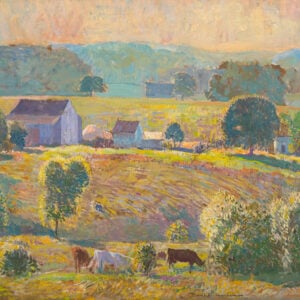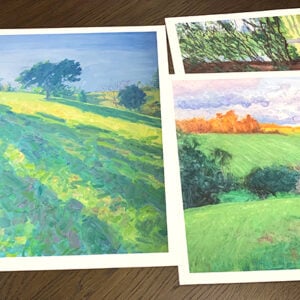One of the issues with painting is that it requires space. With your easel, paints, canvas, storage boxes and whatever else you use to paint, it can be a struggle to paint if you do not have a dedicated art studio.
So do you need a dedicated art studio in order to paint? In short, no. Since I started painting I have mostly painted in cramped spaces (see below from when I used to paint in my apartment room).
- 1. Light Is the Most Important Factor in Deciding Where to Paint, so Prioritize That
- 2. Room to Move
- 3. If neither of the Above Are Possible, Then You May Want to Consider Painting Plein Air
- 4. You Will Need to Consider Ventilation, Especially if You Are Oil Painting
- 5. More Planning, Less Cleaning Up
- 6. Tarp and Old Sheets Are Your Friends
- 7. Try to Avoid Children, Pets and Distractions if You Can
- 8. Use an Easel With Inbuilt Storage Such as a French Easel
- 9. If You Can’t Fit a Standing Easel, Then Consider a Tabletop Easel
- Want to Learn More?
- Thanks for Reading!

I even had to store paintings in my bathroom…

Only recently have I been able to upgrade to somewhere more spacious to paint. It is not a huge art studio by any means but it is more than sufficient for the moment.

Now obviously, it would be preferential for all of us to have grand art studios to hide away and paint in. But that is not always an option due to financial and living constraints. So here are some tips for those of you who must make do without a dedicated art studio.
1. Light Is the Most Important Factor in Deciding Where to Paint, so Prioritize That
When looking for a place to paint, the number one thing you should consider is light. If possible, try and paint in a naturally well-lit room. If natural light is not possible, then you will need to ensure there is enough artificial lighting (I suggest something like fluorescent 5000K/5500K bulbs).
2. Room to Move
The next thing to consider is having room to move around your painting. This is often an overlooked factor of painting. You need to be able to view your painting from many different angles and distances. This will give you more of a complete view of your painting.
You do not need a huge area to move around, just a few different pathways which you can view your painting from.
3. If neither of the Above Are Possible, Then You May Want to Consider Painting Plein Air
If you are not able to paint in an area that has appropriate lighting and room to move, then you may want to consider painting plein air (outside). This will certainly solve your light and space issues. However, you will have to deal with the challenges of painting plein air, such as the ever-changing environment.

4. You Will Need to Consider Ventilation, Especially if You Are Oil Painting
If you are oil painting, then ventilation is also important. The fumes from oil painting can be intense and irritating. A window and fan should be sufficient.
5. More Planning, Less Cleaning Up
If you do not have a dedicated art studio, then you will probably be forced (or strongly encouraged by relatives or roommates) to keep your painting area clean. By putting in effort to setting up your art supplies in an organized manner and planning your painting, then the cleanup job will be much easier.
6. Tarp and Old Sheets Are Your Friends
You do not want to get paint on your walls and carpets, so tarp and old sheets come in handy here. I usually lay a tarp under my easel to protect the carpet and hang a sheet behind the easel to protect the walls. By doing this, I was able to paint in a small apartment room without damaging the carpet or walls for over a year.

7. Try to Avoid Children, Pets and Distractions if You Can
If you can paint in a place without children, pets or other distractions then that would be preferable. Otherwise, I suggest earphones to keep you in focus.
8. Use an Easel With Inbuilt Storage Such as a French Easel
The French easel has been good to me with the inbuilt storage to hold my paints and palette knives. If you only have a small area to paint, then you will need to select a more compact easel to paint on (no giant H-frame easels unfortunately).
9. If You Can’t Fit a Standing Easel, Then Consider a Tabletop Easel
A very compact option is painting on a tabletop easel. This way you can paint on any table in your residence. However, this may not suit larger canvas sizes.
Want to Learn More?
You might be interested in my Painting Academy course. I’ll walk you through the time-tested fundamentals of painting. It’s perfect for absolute beginner to intermediate painters.
Thanks for Reading!
I appreciate you taking the time to read this post and I hope you found it helpful. Feel free to share it with friends.
Happy painting!
Dan Scott

Draw Paint Academy







Interesting. Even though I’m by a window, I can’t arrange the table and easel to my liking.So I got a couple of those natural white light bulbs, and have 2 lamps, it works great.
Hi Glenn. Yes I think it is handy to have white light bulbs in the studio regardless (in case you want to paint at night). Dan
Hi Dan,
This post has been very insightful and inspirational. I can’t wait to get my art space together and begin my creative journey. Thank you so much for sharing!
Great to hear Ashley! Thanks, Dan